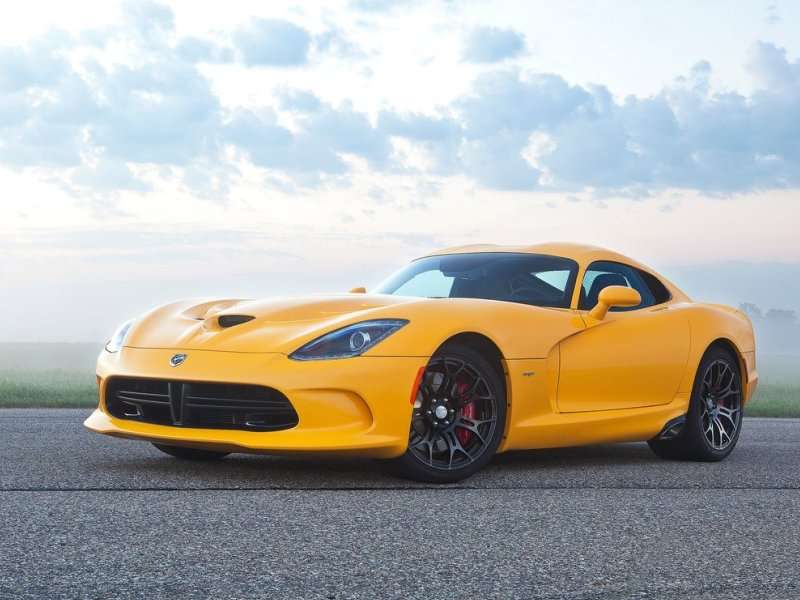Recent Articles
Popular Makes
Body Types
2014 SRT Viper Road Test and Review
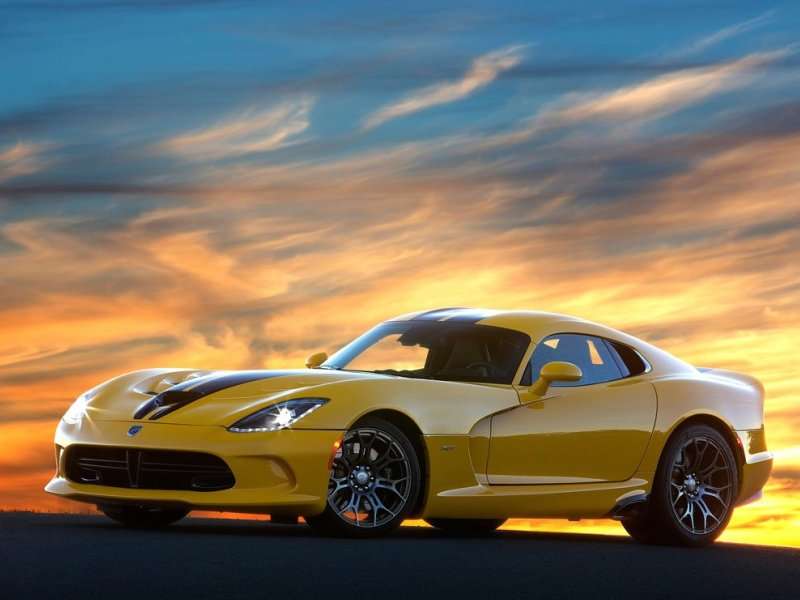
Few cars inspire admiration the way the 2014 SRT Viper does. As much fun as it is to drive, when you’re in possession of the car, you’ll have just as much fun parking it on a busy street outside a coffee house. Get yourself a cup of coffee; find a seat in the window so you can watch the reactions of passersby. You’ll be entertained for quite a while.
These days, everyone has a camera in their pocket everywhere they go. If our experience is typical, there must be several hundred terabytes of jpeg files out there generated by people snapping shots with their smartphone cameras of the new Viper wherever they see it.
And frankly, the car is definitely worthy of the adulation it gets.
Nothing else looks like it; nothing else sounds like it, and absolutely nothing else goes like it does for the price. Quintessentially American, the contemporary Viper is just as outrageous as any model boasting the striking serpent logo has ever been. But it now also possesses a nod toward civility (a very slight one, but a nod nonetheless) making it a bit easier to both live with and drive.
2014 SRT Viper Road Test and Review: Models and Prices
For the 2014 model year, SRT (nee Dodge) is offering the Viper in one body style and four states of trim. These are the $102,485 SRT Viper, the $118,485 Viper TA, the $124,985 SRT Viper GTS, and the $138,885 SRT Viper GTS Anodized Carbon Special Edition.
Standard equipment on the base SRT Viper includes 18-inch front wheels, 19-inch rear wheels, summer tires, automatic bi-xenon headlights, LED daytime running lights and taillights, keyless ignition/entry, full power accessories, cruise control, a tilt-only leather-wrapped steering wheel, auto-dimming mirrors, and an automatic climate control system. Electronic features include an 8.4-inch touchscreen, Bluetooth phone and audio connectivity, and a nine-speaker sound system with satellite radio, an auxiliary audio input, a USB interface, and an SD card reader.
A Grand Touring package is available for the base model, which nets a cupholder insert, floor mats, a rearview camera, voice-controlled navigation, and HD radio.
Viper GTS comes with all of the above, plus a unique hood and wheel design. The GTS Viper’s leather upholstery uses contrasting stitching on the dash, door panels and center console. GTS model’s seats are trimmed in leather with faux suede inserts, and the driver’s seat is power adjustable. Completing the package, the audio system is upgraded to a 12-speaker setup by Harman Kardon. On the go-faster side, the GTS gets a set of dual-mode driver-selectable Bilstein shocks, upgraded two-piece lightweight brake rotors, and a multi-stage electronic stability and traction control system.
The Viper TA (or Time Attack) gets the SRT Advanced Aerodynamics package featuring a carbon fiber rear deck lid spoiler and a two-piece front air splitter, along with lightweight wheels, softer compound Pirelli P-Zero Corsa tires (for better roadholding), and TA-specific exterior and interior trim. A track-oriented package, the TA kit also features a very firm racetrack-focused suspension configuration, and special Brembo brakes featuring two-piece rotors with increased thermal capacity for additional resistance to brake fade.
The Anodized Carbon Special Edition Viper gets a matte-finished paint job, gloss black badges, satin black exhaust bezels, and a satin black fuel filler cap. Black Vapor Chrome wheels and carbon fiber brake ducts further adorn the exterior. Inside the ACSE Viper, Alacantara upholstery, orange stitching, orange HVAC vent trim, and carbon fiber accents set the car apart from ‘regular” Vipers.
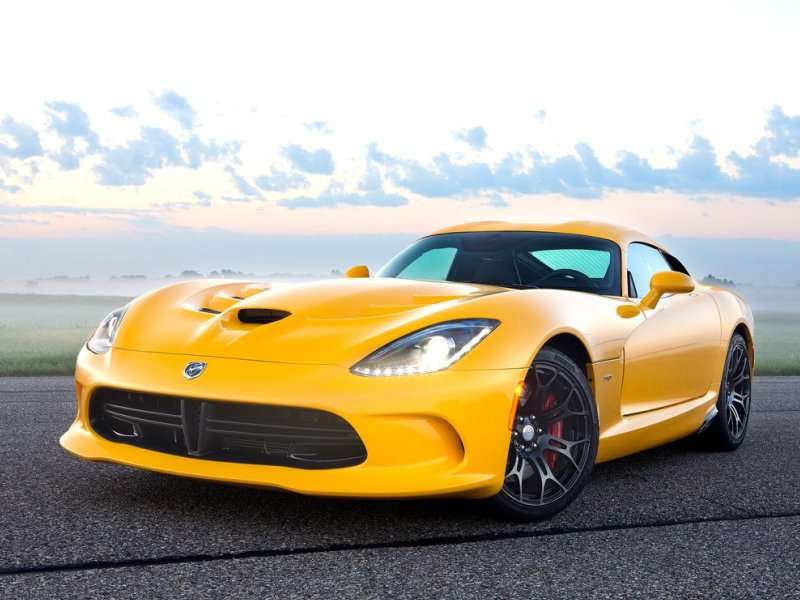
2014 SRT Viper Road Test and Review: Design
The exterior design of the Viper, while all new, is immediately recognizable. An evolutionary design, the look of the car easily traces its roots back to the very first Viper model introduced in 1992. Since then, there have been three other generations of the car, each more aggressive than its predecessor.
The Viper’s design language is chiefly characterized by a low stance and an extremely rearward cab position, which in turn necessitates a very long hood. Another cue going all the way back to the first car is the gills in the fenders, needed to extract the tremendous amount of heat the Viper’s massive engine produces. Speaking of those gills, the one on the left side of the car houses the release for the front-hinged hood. (You’d go crazy looking for it if nobody ever told you where it was—trust us.)
If you look closely, you’ll note the roof of the coupe contains a slight indentation, creating a double-bubble design. This enhances interior headroom and allows for the use of helmets as well. The detail-oriented observer will also note the front of the car has a definite serpent-like appearance to it, all the way down to a pair of fangs in the lower front grille.
Other interesting detailing includes the snakeskin pattern in the taillights, the grille covers for the side gill openings, and in the vents in the hood. As has been the case on every Viper model since the car was introduced, the exhaust outlets are on the sides of the car just forward of the rear wheels.

2014 SRT Viper Road Test and Review: Comfort and Cargo
Very few production cars are as performance focused as the Viper. Anyone settling behind the wheel and expecting to experience the comfort of a more conventional car will be disappointed. But don’t be put off by that statement, as this version of the Viper is more comfort-oriented than any previous version of the car. The seats are narrow, firm, and use very deep bolstering in their quest to keep you in place—should you decide to exercise the SRT Viper’s full potential.
That said, the interior design of the fifth generation Viper exhibits the most significant attention to style and workmanship ever offered with the model. All of the major interior surfaces are sewn and wrapped. Further, additional padding is applied in comfort areas in an effort to further civilize the car.
Of course, the Viper is still far from being practical as a daily driver, but the time you do spend in the car will be more comfortable than in previous versions of The Chrysler Group’s supercar. Particular attention has been paid to the fit and finish of the interior components, lending the interior an air of quality heretofore overlooked.
Occupants will also find the interior of the current car more spacious than before. In fact, according to SRT spokespeople, this is the most spacious Viper in the history of the car. What’s more, while interior storage space is at a premium, the Viper does boast a reasonably capacious cargo area. You’ll find just over 14 cubic feet of readily accessible storage space behind the seats. Also, the rear hatch, while a bit on the heavy side does open wide enough to make putting overnight bags back there a reasonable proposition.
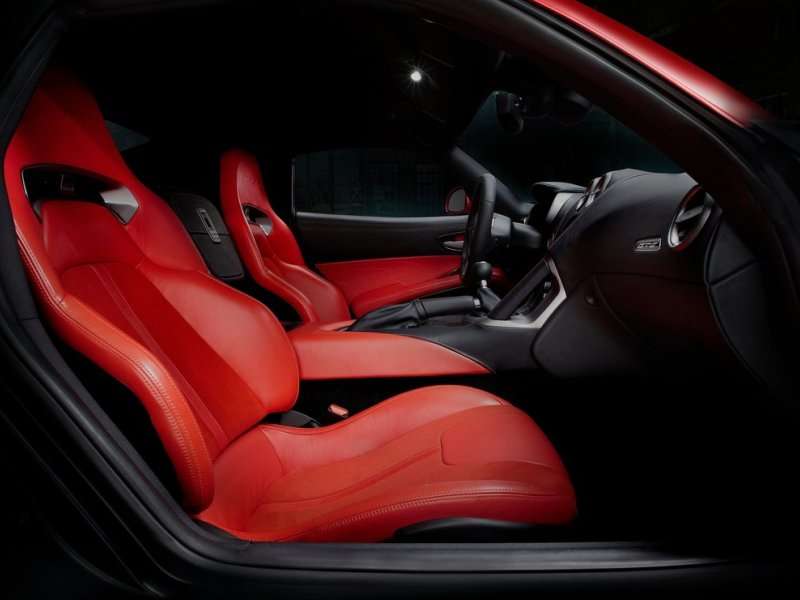
2014 SRT Viper Road Test and Review: Features and Controls
Facing the Viper’s steering wheel, you’re confronted with a huge analog tachometer. However, all of the other instrumentation is digital and displayed courtesy of the seven-inch full color instrument panel, which can be customized to a number of different configurations—depending upon the information you value most.
The tachometer is set up to glow red when the engine is nearing redline, so the driver doesn’t have to focus on the needle to know when an upshift is required. The tach can also be set up to recall shift points and peak rpm attained. The SRT performance pages, offered in all SRT models, will recount 0-60, 0-100, eighth- and quarter-mile ETs, braking distances, G-forces, and top speed.
An 8.4-inch monitor dominates the center stack and contains the audio system, navigation system, climate control system, and communications system. It can also be configured to show the SRT data. Chrysler’s Uconnect Access in-vehicle connectivity system is also fitted. Additionally, there are secondary knobs for the radio, climate controls, navigation system, and phone. If your smartphone is supported and Sprint is your carrier, you can generate text messages by speech and the system will also read text messages back to you.
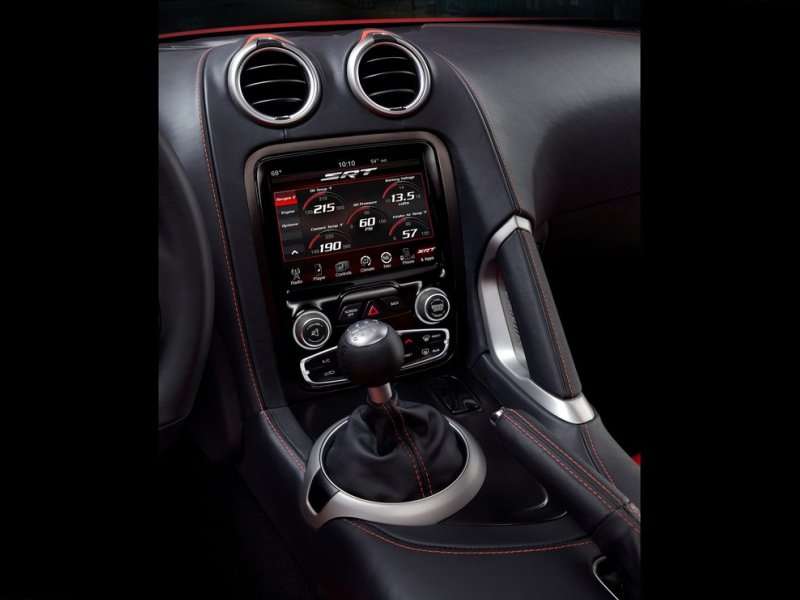
2014 SRT Viper Road Test and Review: Engines and Fuel Economy
Just as it has been from the very beginning, the key feature of the Viper is the hand-built 8.4-liter aluminum V10 engine. Mounted so it sits behind the centerline of the front wheels, the V10 delivers 640-horsepower and 600 ft-lbs of torque. This makes the Viper the most torque-rich normally aspirated road car currently on offer.
Details of the engine include an ultra-high-flow lightweight composite intake manifold; high-strength forged pistons; sodium-filled exhaust valves; free-flowing catalysts to ease backpressure; and an aluminum flywheel to reduce reciprocating losses. In addition to making the V10 wind more freely, these efforts have also resulted in shaving approximately 25 pounds from the previous Viper’s engine.
Power is transmitted to the rear wheels by way of a Tremec TR6060 six-speed manual transmission with closer gear ratios than the previous model’s, The final drive ratio has also been shortened, from 3.07 to 3.55. To improve drivability, the shifter’s throw is shortened over that of the previous car’s as well. The Viper’s 206 mph top speed is now attained in sixth gear at the 6,200 rpm redline.
As you might imagine, the Viper is definitely more about smiles per gallon than it is miles per gallon. With a zero to 60 of 3.7-seconds, it comes as no surprise to find the EPA says to expect 12 mpg in the city, 19 on the highway, and 15 overall.
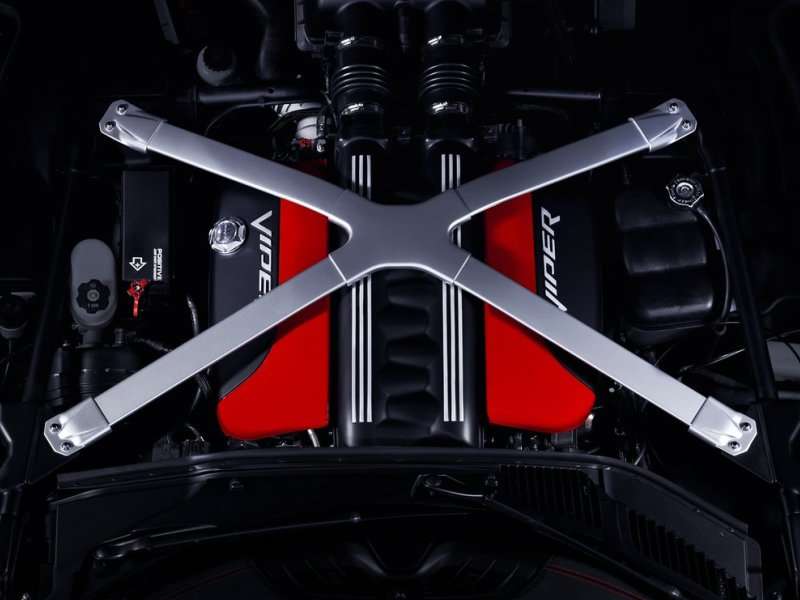
2014 SRT Viper Road Test and Review: Driving Impressions
Before we go any farther, if you haven’t already figured it out, this is a car you drive with a healthy sense of respect for its capabilities. Yes, new driver aids have been added to help keep the Viper under control, but this is a car you drive, you don’t let the Viper drive you—because in most cases you will NOT be able to keep up.
The capabilities of this car are so far beyond the skills of the average driver, we highly recommend you avail yourself of the one-day SRT track experience, which is included in the purchase price. This is an incredibly powerful car, with extremely high limits. Thing is, when you overstep those limits, the car gives you very little warning, and if you’re all the way out on the ragged edge of its potential and lose it, the result will very closely resemble the aftermath of a thermonuclear incident.
The good news is the car warns you what it’s about from the moment you try to set it into motion. Its controls are very heavy at low speeds. The clutch pedal is stiff, the brake pedal is hard, and you feel every bump in the road because the suspension system is so taut. The shift lever even resists shifting when the car is moving slowly.
Of course, those of us who have a deep and abiding appreciation for fast cars know this means the Viper will let you perform some absolutely incredible maneuvers on the road. Once you’re up to speed, all of those detriments drop away and you very quickly come to understand the Viper is calibrated for fast running—not trundling around town at parade speeds.
Once it’s warmed up, loose and running freely, the steering feel is incredible, the braking is instantaneous, and the throttle response is sublime. What’s more, the Viper exhibits incredible grip in the corners. The 2014 SRT Viper is a car you’ll very quickly tire of driving slowly, but very slowly tire of driving quickly.

2014 SRT Viper Road Test and Review: Safety and Ratings
ABS, stability control, traction control, driver and front passenger airbags, Uconnect roadside assistance and emergency services. Plus your common sense…use it freely.
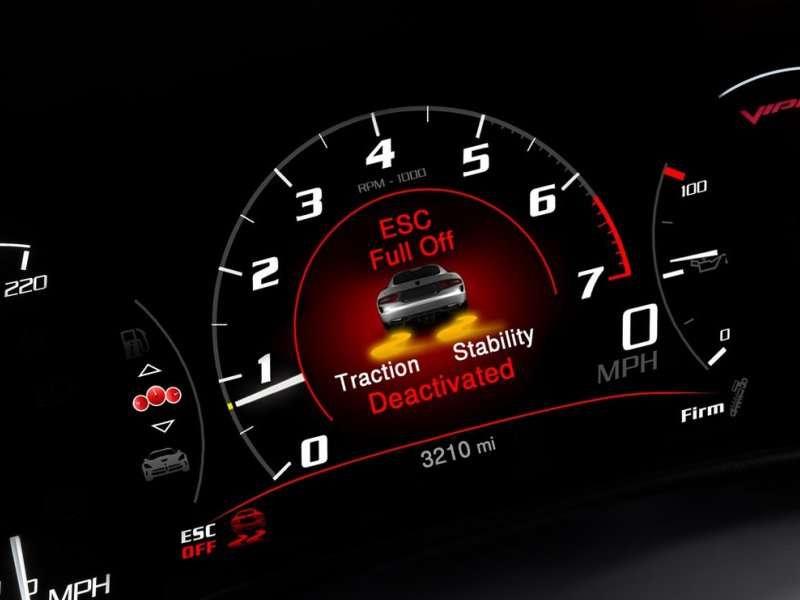
2014 SRT Viper Road Test and Review: Final Thoughts
This pretty much says it all…
- Top speed = 206 mph
- 0-60 mph = low 3-second range
- Quarter-mile E/T = mid 11-second range
- 0-100-0 mph E/T = less than 12 seconds
- Braking distance from 60 mph = 106 feet
- Coefficient of drag (Cd) = .369
But just in case it doesn't for you, these guys know more about the car than anybody else…

2014 SRT Viper Road Test and Review: Pros and Cons
• More power than you’ll possibly ever need
• A rich legacy
• Striking appearance—nothing else looks like it
• Low fuel economy
• Too hardcore to be a daily driver
• Outward visibility can be limited in some circumstances
